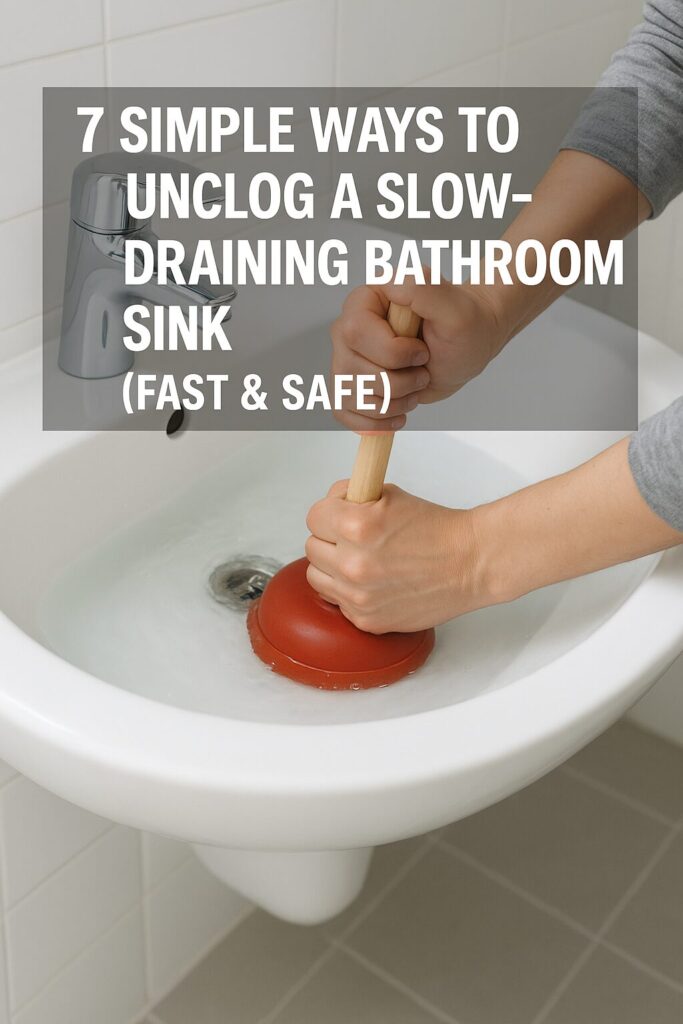
Need to unclog a slow-draining bathroom sink? This guide walks you through fast, safe methods—from boiling water to cleaning the P-trap—so you can restore flow without calling a plumber. Whether the cause is soap scum, hair, toothpaste buildup, or hard water deposits, you’ll find a practical way to unclog a slow-draining bathroom sink and keep it clear.
Quick Answer (in 3 lines)
- Start with heat (boiling water) and a sink plunger to dislodge soft buildup.
- Use vinegar + baking soda, then flush; try a plastic drain snake for hair clogs.
- Clean the P-trap if flow is still slow; reassemble and test for leaks.
What You’ll Need
- Kettle or pot (for boiling water)
- Rubber sink plunger (cup style)
- Baking soda + white vinegar (or enzyme cleaner)
- Plastic drain snake / zip tool
- Adjustable wrench, bucket, old towel
- Gloves and eye protection
7 Simple Ways to Unclog a Slow-Draining Bathroom Sink
1) Flush with Boiling Water
Boiling water can melt and loosen soap, toothpaste, and light grease inside the drain. Carefully pour a kettle of boiling water down the drain in two or three rounds, allowing it to work for 15–20 seconds between pours. This alone can unclog a slow-draining bathroom sink if buildup is mild.
2) Use a Sink Plunger (Cup Plunger)
Fill the basin with enough water to cover the plunger cup. Place the plunger over the drain, seal it firmly, and plunge with steady strokes for 20–30 seconds. If your sink has an overflow hole, cover it with a wet cloth to improve pressure. Plunging can break up soft blockages and move them down the line.
3) Vinegar + Baking Soda (Fizz & Flush)
Pour about 1/2 cup of baking soda into the drain, followed by 1 cup of white vinegar. The reaction helps loosen grime and soap scum. Wait 10–15 minutes, then flush with hot water. Repeat once if needed. This is a low-cost, non-corrosive way to unclog a slow-draining bathroom sink and freshen odors.
4) Try a Plastic Drain Snake
Hair is a top culprit in bathroom sinks. Insert a plastic drain snake (zip tool) into the drain and pull it out slowly to catch hair clumps. Repeat several times. This tool is inexpensive, reusable, and often the fastest way to restore flow.
5) Clean the Stopper Assembly
Pop-up stoppers trap hair and slime right under the flange. Remove the stopper: under the sink, loosen the pivot nut on the drain tailpiece, pull the pivot rod, and lift the stopper out from the top. Clean thoroughly, reinsert, and retighten the pivot nut. Test the lever action and flow.
6) Remove and Clean the P-Trap
Place a bucket under the trap. Use an adjustable wrench (or hand-loosen if it has slip nuts) to remove the curved P-trap. Clear out sludge and debris, then rinse. Inspect the washers; replace if worn. Reassemble, making sure the trap is seated straight. Run water and check for leaks. A clean P-trap will reliably unclog a slow-draining bathroom sink when the clog sits close to the fixture.
7) Use an Enzyme Cleaner (Overnight)
For organic buildup, a monthly enzyme cleaner can help keep drains flowing. Follow the label, usually applying at night so the product can work undisturbed. This is a good preventive step after you unclog a slow-draining bathroom sink.
When to Go Beyond the Sink
If the P-trap and stopper are clear but drainage is still slow, the clog may be farther down the branch line. A hand auger (drain snake) can reach deeper. If multiple fixtures in the bathroom are slow (sink + shower + toilet), you may have a larger line issue—consider a professional to avoid pipe damage.
Prevention Tips
- Use a hair catcher under the stopper or a small screen over the drain.
- Run hot water for 15–30 seconds after brushing teeth or shaving.
- Monthly: baking soda + vinegar, then hot water (or an enzyme treatment).
- Clean the stopper every few weeks—quick wipe prevents big build-ups.
FAQ
How long should I try DIY methods before calling a pro?
If plunging, vinegar/baking soda, and a drain snake don’t noticeably improve flow within an hour, remove and clean the P-trap. If that fails, the clog is likely deeper—time to call a plumber or use a professional-grade auger.
Is it safe to use chemical drain cleaners?
Most chemical drain cleaners are harsh on finishes and can damage older pipes, gaskets, and septic systems. Try heat, mechanical removal (snake), or enzyme cleaners first. If you do use chemicals, follow the label exactly and never mix products.
Why does my sink slow down again after a few weeks?
Hair and toothpaste film re-accumulate on the stopper and tailpiece. Regularly cleaning the stopper and doing a monthly enzyme or vinegar flush helps keep things clear so you don’t have to repeatedly unclog a slow-draining bathroom sink.
Helpful Resources
- Family Handyman: Unclog a Bathroom Sink
- This Old House: How to Unclog a Drain
- EPA: Homeowner Septic Resources
Explore More on AnswerNimbus
Want more step-by-step fixes? Explore our How-To & Fixes guides for practical solutions you can use today.
AnswerNimbus is an online knowledge hub providing step-by-step guides, how-to fixes, and clear explanations across technology, home, collectibles, and everyday curiosities. Our mission is to make useful information easy to find, understand, and apply.
